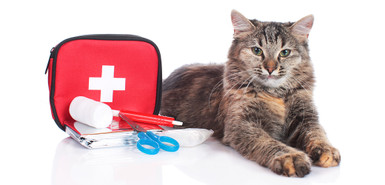Posted by Jessica Roberts on Sep 1st 2020
How to Build Your Own Pet Emergency Kit
When it comes to four-legged family members, you can never be too prepared for an emergency. If a natural disaster is forcing you to evacuate or shelter in place, it’s important to have your pet’s most essential items prepared and easily accessible. To help you get organized, we’ve created this useful checklist so you can put together your own DIY emergency kit for your pet.
What to Use for Your Pet Emergency Kit
Before you assemble your pup’s emergency kit, you’ll need to choose what type of container to use. A plastic tub or waterproof backpack are good choices, depending on how much space you have to work with. Your kit should be able to carry supplies for three days if you’re planning to evacuate on foot, or one week’s worth of supplies if you’ll be evacuating by car or sheltering in place. To be prepared for any circunstance, pack a smaller “go-bag” inside your larger emergency kit with supplies that can be easily grabbed to take with you.
Your Pet Emergency Kit Checklist
A well-stocked emergency kit for Fido should include the following essential suppkies:
- Pet Food: Pack a week’s worth of your dog’s food in an airtight, waterproof container like the Vittles Vault. Add a collapsible bowl like the Kurgo Collaps-a-Bowl Travel Bowl, which is portable and takes up only a small amount of space.
- Drinking Water: During a natural disaster, clean water can be hard to come by. Keep a week’s worth of potable water on hand for each family member, including pets. If you anticipate a possible evacuation, the LumoLeaf Water Bottle for Dogs makes hydrating your pup on the go easy and mess-free. It also includes a removable aluminum buckle, so you can attach your water bottle to your kit.
- Medication and First Aid: If your dog takes regular medication, store a 30-day supply in your pet emergency kit. Additionally, pack a complete pet first aid kit and a guide to basic pet first aid basics in case of injury. This Pocket-size Pet First-Aid Guide is a well-organized and thorough manual that won’t take up much room.
- Blankets or Beds: A familiar item can help relieve boredom and reduce anxiety for pups in an unfamiliar situation. Along with including a comfort item such as a blanket, travel pet bed or a quiet chew toy, “rescue blankets” are a smart addition to your pack. These LIT FITNESS emergency blankets are lightweight, waterproof and can be used to provide you and Fido thermal protection and shade.
- Leashes and Waste Disposal: Always include an extra leash and collar in your pet emergency kit, in case your primary set gets damaged or lost. Pack waste bags and puppy pads also, in the event your pup has to be contained in the car or community shelter, or has to shelter in place for an extended period.
- Vaccination and Medical Records: Create your pet profile on BringFido’s app for iPhone or Android, where you can upload your pup’s vet records and medical history for easy access wherever you are. Your emergency kit should also include a waterproof bag or container with documentation including shot records, photos and descriptions of each pet, and your contact information, in case your phone is not accessible.
- Visibility Solutions: Include a high-visibility vest or LED collar so your canine companion can be seen day and night in inclement weather. These items weigh very little and take up minimal room in your kit, but can be invaluable in an emergency.
- Other Items to Consider: While the above supplies are must-haves, the greatest benefit of building a DIY pet emergency kit is that you can tailor it to your dog’s particular needs. For example, a doggy life jacket if you live in a flood zone, a crate or carrier for smaller pets, rain jackets or booties, and anxiety solutions can also be useful additions to a go-bag.
Storing Your Pet’s Kit
Store your pet’s items alongside your family’s human emergency preparedness kit, where it’s easy to access quickly. These supplies should be restocked with fresh food and medications every three to six months. Make sure every family member and a nearby emergency contact are able to retrieve the emergency supplies in case you're unable to return to the house. Also, be sure to regularly update your dog’s microchip any time there are changes to your contact information, as this information becomes vital if you are separated for any reason.

